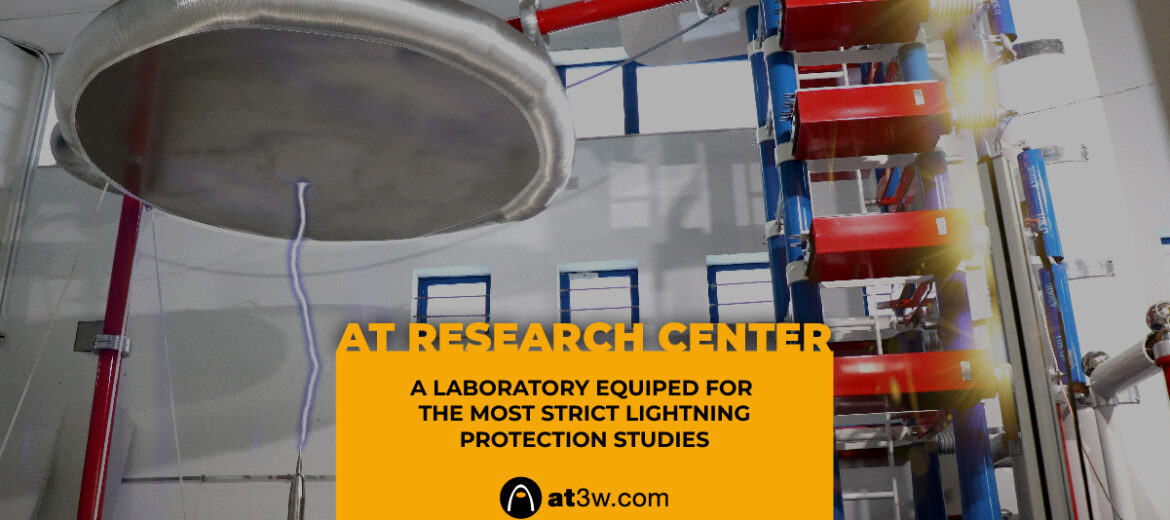Nowadays, there is an increasing demand for guarantees that any equipment or tool is tested in accordance with the regulations to ensure its correct operation. Lightning is a phenomenon capable of causing great personal and material damage, but it is not possible to anticipate exactly when and where lightning will strike. However, it is vital that the systems designed to protect against the effects of lightning operate correctly and in accordance with current regulations. Aplicaciones Tecnológicas has the AT Research Center, one of the best-equipped laboratories in the world for testing Lightning Protection Systems (LPS), where the most demanding tests are carried out to measure the reliability of all its components.
It is not possible to reproduce the complete lightning phenomenon in a laboratory, so it is necessary to separate its two main components, voltage and current, to carry out separate tests and, in this way, test the effectiveness of Lightning Protection Systems (LPS) so that they comply with current regulations and with their ultimate function: to protect against the destructive effects of atmospheric discharges.
An Early Streamer Emission (ESE) air terminal is a high-tech lightning rod, which is characterised by emitting a continuous upward tracer before any other object within its protection radius. This advance in the emission of the tracer is measured in the laboratory with tests described in the regulations applicable to this equipment. Aplicaciones Tecnológicas’ DAT CONTROLER® REMOTE lightning conductors are tested in accordance with these regulations. In addition, and thanks to our AT Research Center laboratory, they can be subjected to more stringent tests in order to provide the best performance guarantees.
Lightning protection standards define the effectiveness of a protection system by means of Protection Levels (PL). The most demanding level (NP I) must be able to capture and withstand the effects of at least 99% of lightning strikes, taking into account existing statistics on lightning characteristics. One of the most critical parameters in this definition is the peak current: they must be able to withstand peak currents of 200kA (10/350µs wave ), which is the figure that corresponds to 99%.
AT Research Center, beyond the standard for better lightning protection
Aplicaciones Tecnológicas has the AT Research Center, one of the laboratories with the best equipment in the whole world for the development of products and services in the field of prevention and protection against the effects of atmospheric electrical discharges. Various lightning conditions are reproduced here to test LPS components in a controlled environment.
At the AT Research Center, 250kA of current is applied in electrical stress tests, well above the regulatory requirements, so that Aplicaciones Tecnológica’s products can be used in installations of any level of protection.
The voltage (the electric field) is used to reproduce the conditions under which lightning interception occurs. The AT Research Center’s 1.2 MV High Voltage Laboratory is focused on the evaluation of the processes prior to a lightning strike: lightning formation, propagation and interception.
The current is used to verify that the SPCR components (arresters, connecting components, fasteners, conductors, etc.) are able to withstand the electrical, thermal and mechanical effects of lightning once it has been intercepted so that it can be safely conducted to the grounding system. The High Current Laboratory of the AT Research Center has two high current generators: a generator of 250 kA of maximum current in wave 8/20 µs and another of 320 kA in wave 10/350 µs. This laboratory is dedicated to the testing and study of direct and indirect lightning effects and is used to evaluate internal and external protection systems.
Additional tests: robust equipment protected against all adverse situations
The elements of an external protection system are installed outdoors, so they must be prepared to withstand any weather conditions, prevent corrosion and, in general, maintain their operating characteristics over time.
At the AT Research Center, the severe effects of an atmospheric discharge are reproduced, as well as other types of additional tests that allow us to verify the maximum robustness of the equipment developed, such as climatic, insulation, ageing, mechanical tests, etc.
If you would like to know more about Aplicaciones Tecnológicas S.A.’s lightning protection products and services, you can contact us through this link.
If you wish, you can also attend any of our free online training courses on lightning protection on our webinars page.
